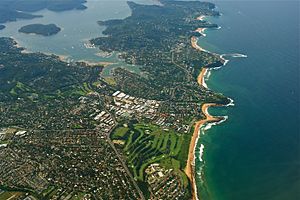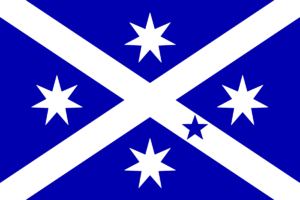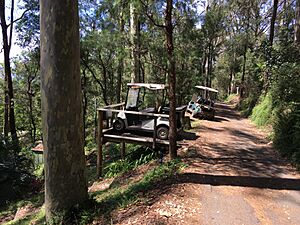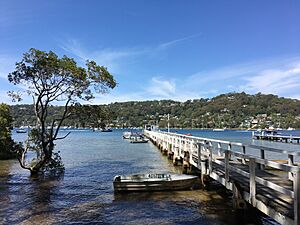Scotland Island facts for kids

Scotland Island is a small island and a suburb located in the Northern Beaches area of Sydney, New South Wales, Australia. It's a special place because it's one of only two islands in Sydney where people live. The main place on the mainland that serves Scotland Island is Church Point. This is about 32 kilometres north of the centre of Sydney. The island is part of the Northern Beaches Council area.
Contents
Island Geography
Scotland Island sits in a beautiful waterway called Pittwater, right off Church Point. The island is about 1 kilometre wide. Its highest point is over 90 metres above the sea. To the east, you'll find the suburb of Newport. To the west is the large Ku-ring-gai Chase National Park. South of the island are the suburbs of Church Point and Bayview.
How the Island Formed
About 18,000 years ago, Scotland Island was actually a hill in a river valley. After the last ice age, the sea level rose a lot. This flooded the valley, creating Pittwater and turning the hill into the island we see today. The island has many small beaches. These beaches are mostly made of mud, mangrove trees, and rocks. There are no big rivers or tall cliffs on the island. However, you can find some small caves closer to the top of the island. The top part of the island is made of sandstone. The lower parts are made of older sedimentary rocks.
Island History
For thousands of years before Europeans arrived, the Guringai people lived on Scotland Island and around the Pittwater area. They were the first people to call this land home.
European Settlement
Soon after the first European settlement in Sydney Cove, the area was explored. Governor Phillip named the island after William Pitt the Younger, who was the British prime minister at the time. The first European to own land on the island was Andrew Thompson. He was a former convict who renamed it Scotland Island, after his home country. Andrew Thompson ran a successful salt works here. He also built boats until he passed away in 1810.
The island was sold a few times during the 1800s. Then, in 1906, it was divided into smaller pieces and sold off. Around 1900, people were still getting salt from the seawater near what is now called Tennis Court Wharf. They used an oil burner to get about 90 kilograms of salt each week!
Life on the Island
At one time, there were sheep farms on Scotland Island. But people started moving there permanently after electricity was connected in 1962. Today, most people who live on the island travel to the mainland for work.
Aboriginal Heritage
There are many Aboriginal Middens on Scotland Island. A midden is like an ancient rubbish dump, showing where people lived and ate. One important midden is in Catherine Park. Here, you can find many shells and other old items. This midden is thought to be about 3,500 years old. A special tree there was also planted by the local Aboriginal people. All Aboriginal cultural places and items in New South Wales are protected by law. It is against the law to disturb or destroy these places. You should never remove items from these sites.
Island Community
Scotland Island is one of only two islands in Sydney where people live. You can get to the island by taking the Church Point Ferry. Many people also use their own private boats. Most of the island is covered in bushland. About 350 houses are built around the edge of the island, near the water. There are no shops, cafes, or industrial areas on the island.
The island has a kindergarten, a Community Hall, and a Fire Station. The Child Centre and Community Hall were built by the residents themselves in the 1980s and 1990s. These buildings are used for many different activities. Community groups on the island include a regular discussion group. There is also an international folk dancing group. In 2006, the community even organised an arts and film festival on the island. Sadly, a fire in a nearby art gallery destroyed many artworks by artists living on Scotland Island.
Since there are no roads to the island, the volunteer fire brigade is very important. The Scotland Island Rural Fire Brigade (SIRFB) helps with many essential services. These services are usually done by full-time emergency workers in other parts of Sydney. The SIRFB is made up of volunteers. About 30 members are active firefighters. Another 30 members help with other tasks that don't involve fighting fires.
Island Residents
In the 2021 census, there were 711 people living on Scotland Island. Most people, 63.2%, were born in Australia. The next largest groups were from England (9.4%), New Zealand (3.1%), and the United States of America (2.7%). Most people (84%) spoke only English at home. Other languages spoken included German (2.3%) and French (2.1%). When asked about religion, 61% said they had no religion. Others were Catholic (12%) or Anglican (9.1%).
Scotland Island is well-known as a place where many Sydney artists and musicians live. Some famous residents include Rob Suzs from the band The Dynamic Hepnotics. Blues and roots singer Jackie Marshall also lives there.
Notable People
- Kristina Keneally is a well-known person who lived on Scotland Island. She was a former New South Wales premier and a Labor Senator. Kristina and her family moved away for a short time. But they returned to live full-time on the island after the 2022 federal election.
Island Climate
The climate on Scotland Island has warm temperatures and rain spread throughout the year. Summers are usually a bit wetter than winters. Much of the rain comes from thunderstorms. This type of weather is called a "Humid Subtropical Climate."
| Climate data for Scotland Island, New South Wales | |||||||||||||
|---|---|---|---|---|---|---|---|---|---|---|---|---|---|
| Month | Jan | Feb | Mar | Apr | May | Jun | Jul | Aug | Sep | Oct | Nov | Dec | Year |
| Mean daily maximum °C (°F) | 26 (78) |
26 (78) |
24 (76) |
22 (72) |
19 (66) |
17 (62) |
16 (60) |
17 (63) |
19 (67) |
22 (71) |
23 (74) |
25 (77) |
21 (70) |
| Mean daily minimum °C (°F) | 18 (65) |
18 (65) |
17 (63) |
14 (58) |
11 (52) |
9 (48) |
8 (46) |
9 (48) |
11 (51) |
13 (56) |
15 (59) |
17 (63) |
13 (56) |
| Average precipitation mm (inches) | 99 (3.9) |
110 (4.3) |
130 (5.1) |
120 (4.7) |
120 (4.7) |
130 (5.1) |
89 (3.5) |
71 (2.8) |
58 (2.3) |
71 (2.8) |
81 (3.2) |
71 (2.8) |
1,150 (45.2) |
| Source: Weatherbase | |||||||||||||




